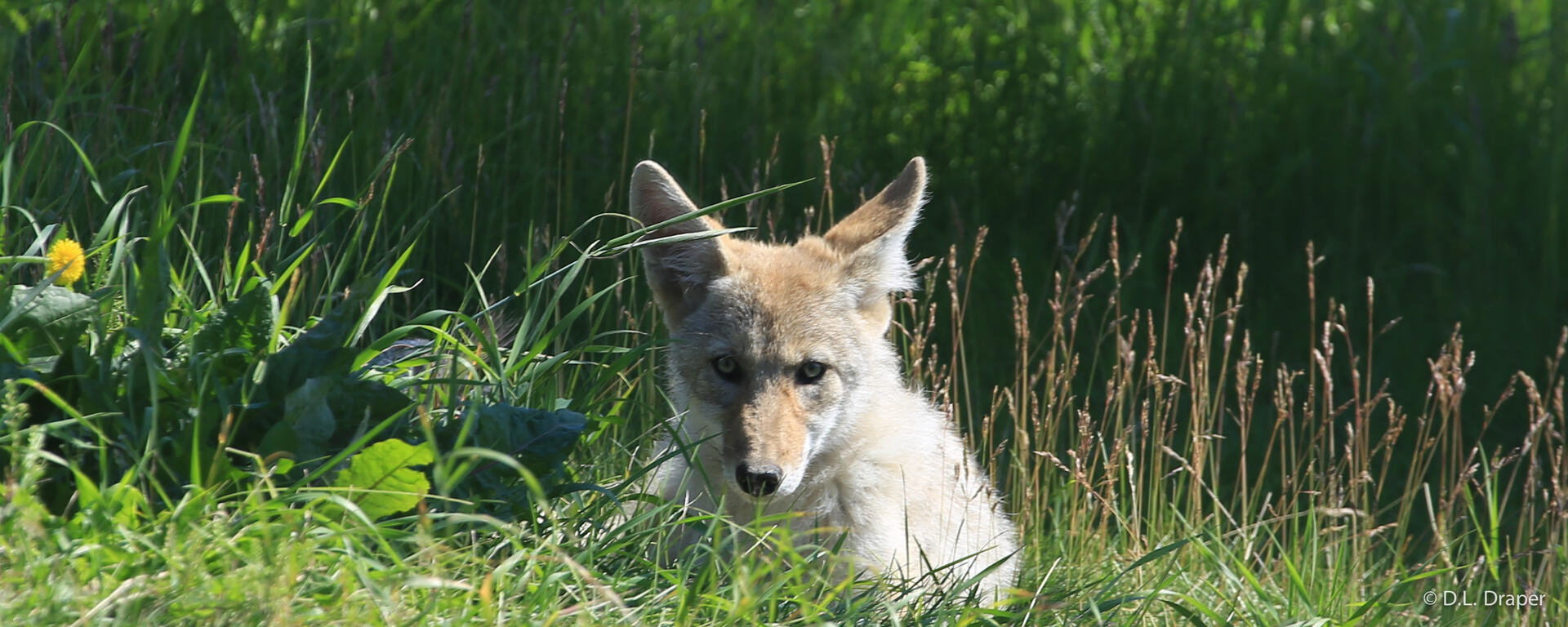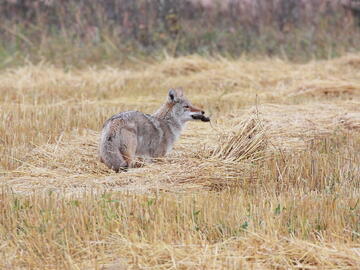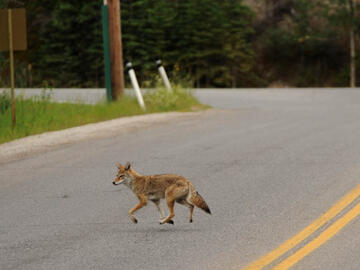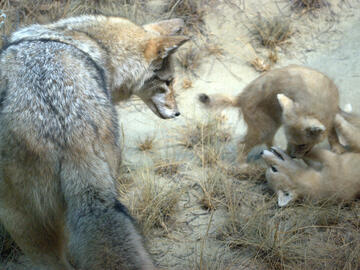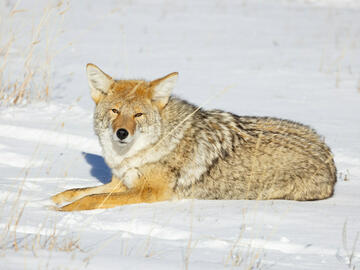The University of Calgary has been home to many wildlife species for decades. Living with Wildlife is a flagship model of co-existence with wildlife, providing our university family and surrounding neighbourhoods with accurate and timely information, education and safety guidelines. This mandate enhances a sustainable approach while minimizing human and wildlife conflict.
Photo by: Dr. Dianne L. Draper, PhD, Department of Geography
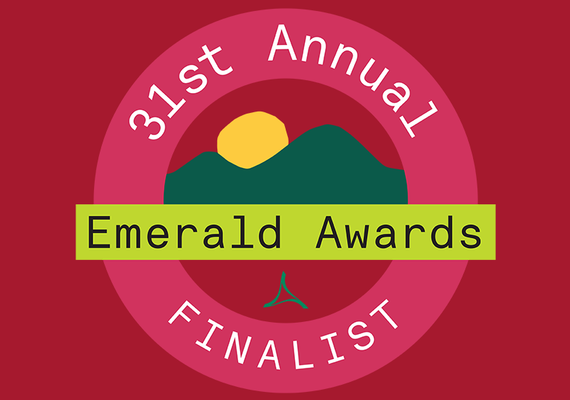
Wildlife Co-Existence Outreach Program
This program aims to empower communities to prevent conflict and foster positive relationships with all wildlife.
Interested in learning more or having your community host a free virtual webinar?
Coexistence with Wildlife
Conflict with wildlife is preventable. These four cornerstones help ensure safety for humans and wildlife.
How people view wildlife often depends on their knowledge and past experiences. Learning about the role coyotes and other urban animals play in our ecosystems, and how to safely share space with them, can lead to better decisions that support coexistence.
Learn more about coyotes
Avoiding conflict with coyotes starts with giving them plenty of space. If a coyote comes closer or you feel unsafe, follow these steps:
- Stop & Stay Calm: Stand still, leash pets, and bring pets and small children directly to your side. Maintain eye contact and do not run.
- Move Away: Assess the situation to tell which way the coyote is going and how you can best move away without blocking its movement. Increase the distance between yourself and the coyote by walking calmly away with purpose.
- Act Big: Raise your arms, clap your hands loudly, open an umbrella or snap a plastic bag, and yell “go away!” to deter the coyote from approaching. Do not scream.
- Prevent: Avoid future encounters by learning where coyotes regularly are seen or heard.
Coyotes are typically raising their pups between April and July. When people or dogs get too close to pups, the parent coyotes may act defensively to protect their young. This behaviour is fear-based, not a predatory attack. They are trying to keep their pups safe. Guarding behaviour is most pronounced when coyotes move pups from the natal den (where they are born) to the rendezvous site (where they grow up).
Coyotes are triggered to protect young by any dog, small or large, but smaller dogs are sometimes mistaken as prey. Whether on or off leash, if a dog gets too close to their pups, the coyote will give warning signs it feels threatened before escalating:
- They may stare or walk towards you and your dog. This is your cue to leave calmly and with purpose, ideally putting 100+ metres between you and the site.
- If you don’t leave right away, the coyote may growl, bark-howl, or even bluff charge to signal that you need to go.
- If you still don’t leave or if your dog approaches the coyote, even while on a leash, the coyote may feel it has to bite to protect its pups.
During pup rearing, an adult coyote may follow you and your dog for a short distance. This “escorting” behaviour is the coyote’s way of making sure you have left the area where you or your dog might be seen as a risk to their young. People often describe this following behaviour as “stalking,” but it is simply the coyote communicating that you and your dog are too close.
Most negative encounters reported during April to July are linked to these normal protective behaviours. Coyotes play a key role in the ecosystem, and it’s important to reduce conflict, especially during denning season. Stay calm, give them space, and avoid challenging a coyote protecting pups. Let them do their job to help keep everyone safe.
Never feed wild animals, especially coyotes. Feeding coyotes — whether directly or by leaving out unsecured food, garbage, birdseed and wildlife feed, pet food, or toys — can cause them to lose their natural fear of people. They may become habituated and start spending more time around homes and yards. If coyotes become dependent on a food source, they may start defending it from pets or people, which can lead to conflict. When coyotes are fed or see people feeding any wildlife, they learn to associate humans with food, which can lead to food-seeking behaviour.
In every known case where a coyote has bitten a person, it was because the animal had been directly fed by people and learned to seek food from humans.
Research shows that removing food attractants is the most important part of any plan to reduce conflict and live safely alongside coyotes (Alexander & Quinn, 2012; Lukasik & Alexander, 2012). Education and monitoring can help, but if food sources remain, even attempts to scare coyotes away will eventually stop being effective.
Killing coyotes doesn’t resolve conflict and can actually make things worse. If food or shelter is still available, new coyotes will move in. When the root cause, like feeding, isn’t addressed, the conflict returns. Lethal action also disrupts coyote social structure. It removes experienced animals that teach their young how to avoid people, and it can cause more coyotes to breed, leading to larger litters and more aggressive, roaming individuals.
It is illegal to feed, harm, or kill wildlife in Calgary and in most municipalities. Wildlife are protected under the Wildlife Act. Feeding wildlife can result in fines or jail time.
If you live in coyote territory, a few small changes around your yard can make a big difference. Start by checking for things that might attract them.
Coyotes promote healthy ecosystems
Coyotes play a crucial biological role, positively impacting all levels of the urban ecosystem. In Calgary, coyotes primarily feed on small mammals, birds, insects, and various plants (Lukasik & Alexander, 2011). Through this diet, they help control rodent populations, manage the expansion of other species, regulate other small predators like skunks and raccoons, have been found to reduce diseases that can transmit to people and pets, and they remove carrion.
Coyote family life shifts with food and space
Coyote families defend their territory from unrelated coyotes. In urban areas, their home range can vary but usually covers a few square kilometres. Sometimes extended family members visit the parents and young, but how many coyotes stay together depends on food and space; this is considered fission-fusion. The average coyote family might be as large as five to eight coyotes when their environment allows, but for most of the year they live in pairs or smaller groups.
In cities like Calgary, they often live as a pair with a caregiver (a young, related coyote), centring activities around smaller green spaces. When coyotes have pups and need to move them, often extended family members return to help the parents.
While coyotes are among the most studied carnivores in North America, UCalgary’s research (Alexander & Quinn, 2011; Lukasik & Alexander, 2011) was the first of its kind in Canada and Calgary. Both studies showed that real conflicts with coyotes are very rare.
Alexander and Quinn (2011) analyzed 12 years of Canadian media coverage to track how often people and pets were attacked by coyotes. On average, fewer than three Canadians are bitten or scratched by coyotes each year. The research also identified two key periods when conflicts increase:
- Pup-rearing season (April–July), when coyotes are denning with pups.
- Dispersal period (September–November), when young coyotes leave their family for the first time.
In the same study, in cases of coyotes biting dogs, about 84 per cent involved pets off leash. Most bites were defensive, not predatory. This means letting dogs run off leash in coyote areas is the main cause of bites. No medium or large dogs were killed during the study period. In half the cases when a coyote grabbed a small dog thinking it was prey, the coyote dropped the dog when a human yelled or chased it away. Leaving small dogs unattended, or letting them wander on an extendable leash, increases their risk of harm, not just from coyotes but also from other wildlife.
Learn about other wildlife on campus
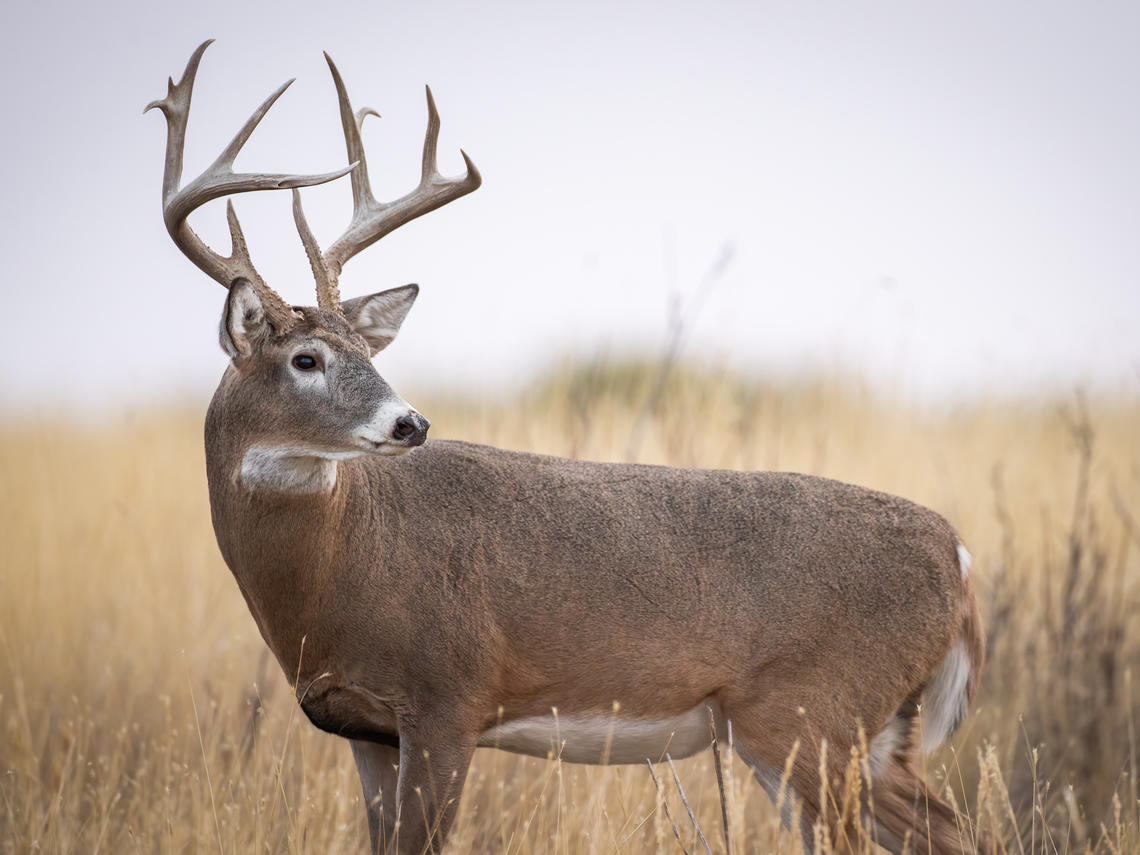
White-tailed Deer
(Odocoileus virginianus)
White-tailed deer belong to the Cervidae family, which includes elk, moose, and caribou. All Cervidae are ruminants (true deer) — hoofed mammals that chew cud by regurgitating food from their stomach. They live across a wide range, from Canada to Peru.15 This adaptability lets them thrive in many habitats, including human-dominated areas. Their appearance, especially their pelts, varies by region.18
White-tailed deer live in sex-segregated herds, with bucks separate from does and fawns. Mothers are very protective of their fawns, which stay hidden in foliage for the first four months of their life. Deer communicate through markings, sounds, scents, and body language. Mothers and fawns have unique bleats, and the raised white tail signals danger.18
They play key roles in ecosystems by controlling grasses and shrubs, dispersing seeds, and feeding larger predators. As primary consumers, their presence greatly affects ecosystem health.
White-tailed Jackrabbit
(Lepus townsendii)
Contrary to their name, white-tailed jackrabbits are actually hares, not rabbits. Both belong to the Leporidae family but are different species. They live across central and western parts of the U.S. and Canada. Jackrabbits usually live in open prairies and grasslands, but they can also be found in mountainous pastures and cities.4 They are mostly active at night, using strong low-light vision to find food.2
They don’t migrate but change their coats with the seasons. Their winter fur helps them blend into their surroundings.4 Breeding runs from February to mid-July. After a short gestation of 30 to 43 days, females have litters of four or five young. How many litters they have depends on where they live.12
White-tailed jackrabbits play a key role in the ecosystem. They are food for predators like coyotes, foxes, and bobcats, and their grazing changes plant growth. Their diet includes grasses and forbs in summer, and shrubs in winter.
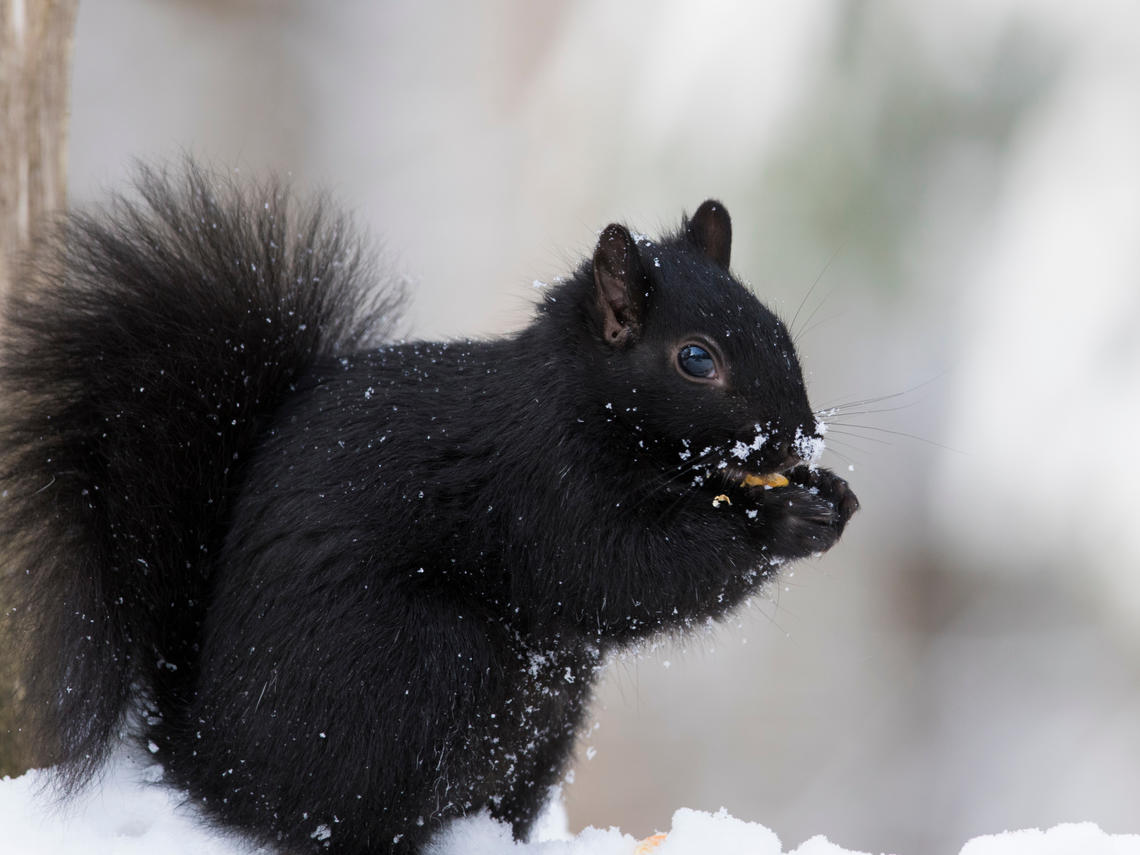
Eastern-Grey Squirrel
(Sciurus carolinensis)
The eastern-grey squirrel belongs to the Sciuridae family, which includes tree, ground, and flying squirrels. They are native to the eastern U.S. and southeastern Canada.9 Most have grey fur with some brown or red, while black morphs (common in Canada) likely help with cold-weather heat regulation.5
These squirrels live mostly in mixed forests but are also common in suburban and urban areas. They are active mainly in the morning and late afternoon but may stay inactive for days during extreme cold. Their diet includes seeds, fruits, nuts, fungi, insects, and sometimes small vertebrates. They bury nuts in fall to eat in winter or spring.9
Breeding happens twice a year, from December to February and May to June. They usually have one or two litters annually, with 2 to 3 young each, after a 44-day gestation. Winter-spring litters are born in tree cavities; spring-summer litters in leaf nests.9
Eastern-grey squirrels are prey for campus predators like coyotes, bobcats, hawks, and raccoons. They also help spread seeds by forgetting where they cached their nuts.
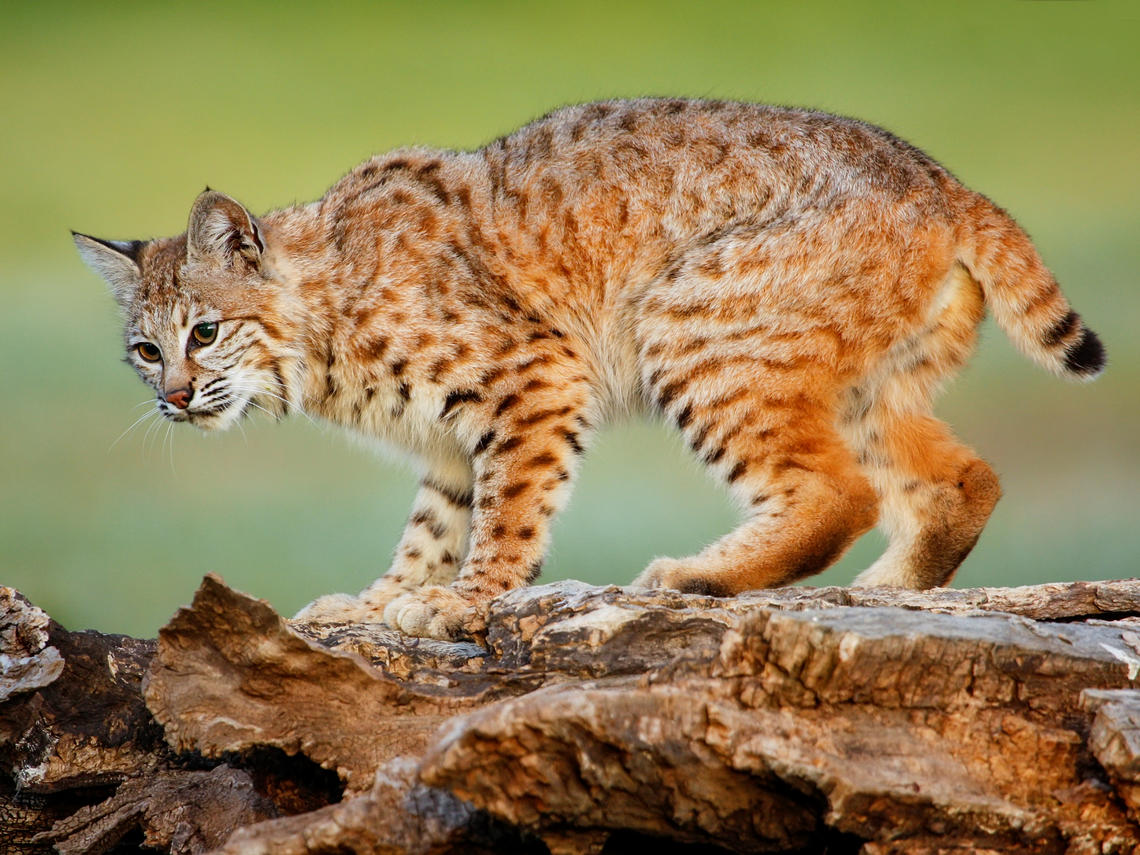
Bobcat
(Lynx rufus)11
The bobcat is closely related to domestic cats, belonging to the Felidae family alongside lions and tigers. Unlike other lynxes, bobcats live farther south and have browner fur than the Canada lynx. They range across the U.S. and Canada, favoring shrublands and dense low vegetation where prey like hares and jackrabbits are plentiful. In summer, they prefer higher elevations; in winter, lower areas.
Mating usually occurs in early spring but varies by location and climate. Both males and females have multiple partners, having litters with one to six offspring after a two-month gestation period. Mothers become aggressive toward males after birth, and as such, males don’t help raise young.
Bobcats are both a top predator and a keystone species. They control populations of small mammals, preventing overgrazing and supporting plant growth.
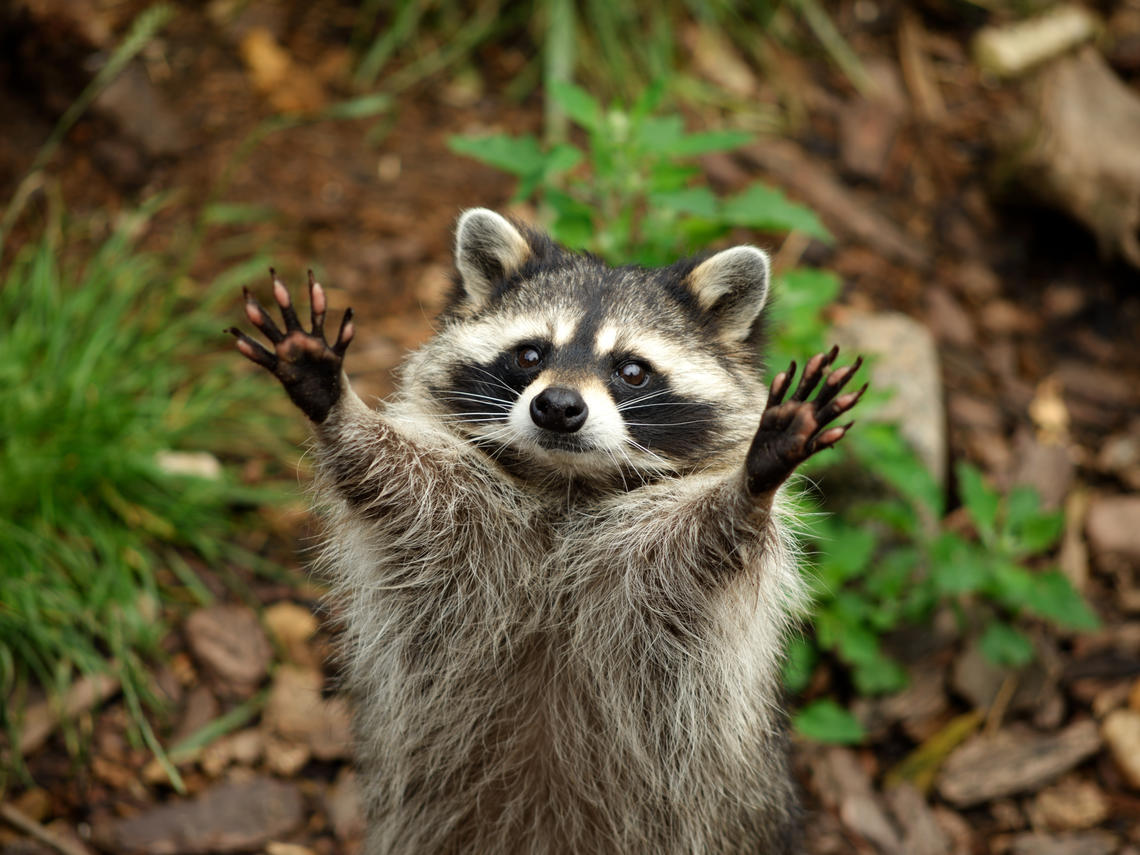
Raccoon
(Procyon lotor)13
Raccoons belong to the Procyonidae family and are closely related to mustelids like weasels. They live across the U.S. and southern Canada, except some parts of Arizona where it’s too hot.
They are versatile omnivores, eating fruits, nuts, seeds, carrion, small birds, and reptiles. When food is plentiful, they’re picky; when scarce, they eat whatever they can. Raccoons are known for washing their food, often found near water. Without water, they rub their food or hands to clean.
Raccoons are mostly solitary except during breeding, but they use over 20 vocalizations, mainly for mating and mother-young communication. Mating season runs from December to June, peaking in February. Both males and females have multiple mates. After mating, they separate, and females raise the young. Gestation lasts about 63 days. Juveniles stay with their mother for nine months before weaning and independence.
As omnivores, raccoons help control small mammals, carrion, and plants. They are also prey for top predators like bobcats and coyotes, making them a key food source.
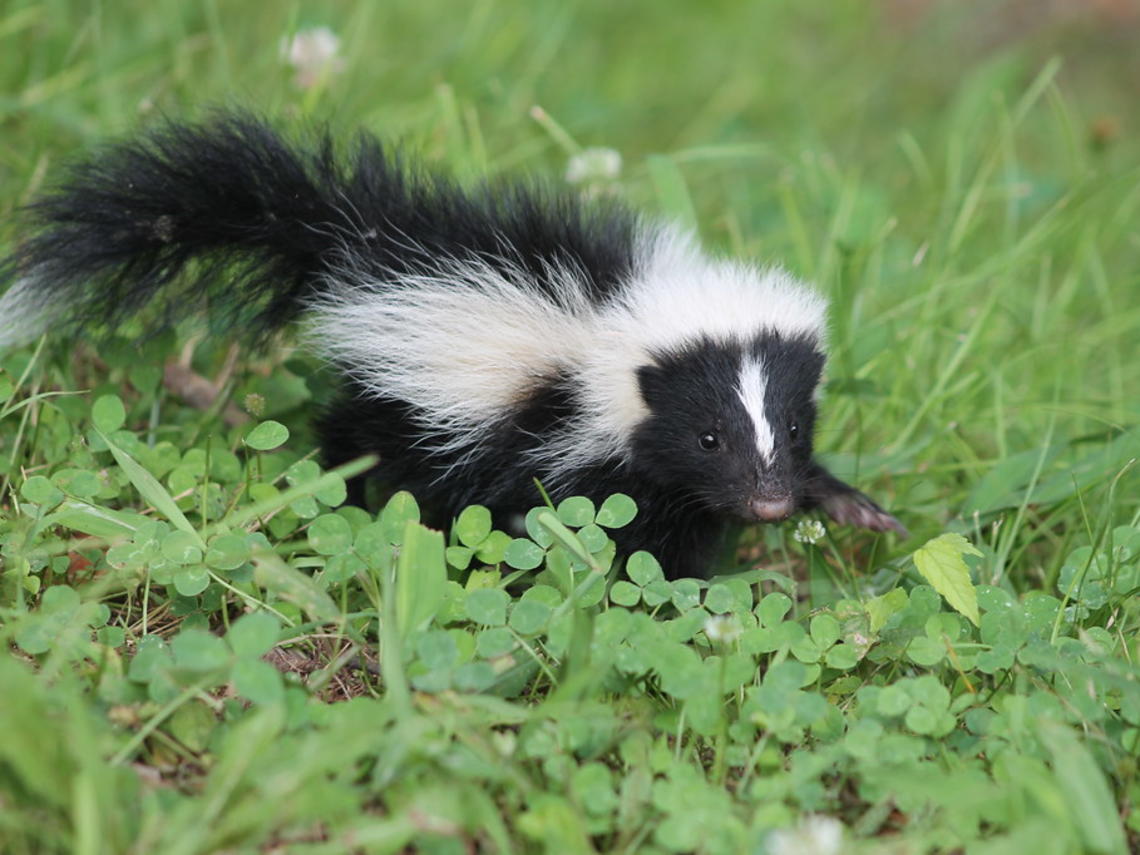
Striped Skunk
(Mephitis mephitis)
The striped skunk is easy to recognize by its black body and white stripes that warn predators about its powerful spray, which the skunk uses only when necessary since spraying costs energy and time.
Skunks belong to the Mustelidae superfamily, which includes weasels, wolverines, and raccoons. Like other members, they live in natural cavities or burrows.8 Highly adaptable, skunks live in various habitats like woods, plains, deserts, and forest edges.27 They also thrive in urban areas, often under houses or garages.10 Their omnivorous diet mainly includes insects but also small mammals, birds, and plants.25
Mating season runs from mid-February to mid-March. After a roughly eight-week gestation, females give birth to litters of 4 to 11 in April or May.8 Skunks are mostly solitary, coming together only to breed or occasionally den in winter. Males mate with multiple females, but females raise the young alone. Babies are born blind and fully dependent on their mother.28
Skunks are both predators and prey. They help control small mammal and bird populations and influence plant growth. They are also food for top predators like coyotes and great horned owls, supporting those populations.
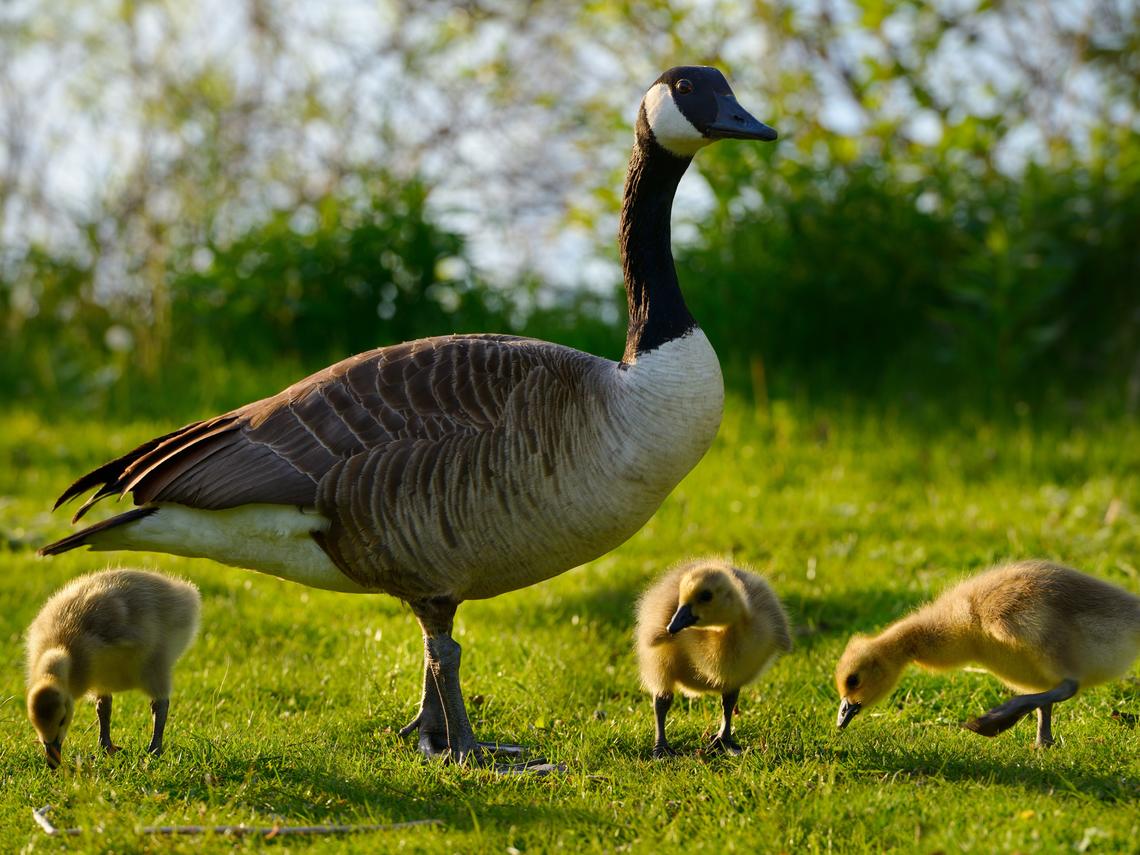
Canada Geese
(Branta canadensis)
Canada geese belong to the Anatidae family, which also includes ducks and swans. Native to North America, they migrate south during winter.16 During migration, geese fly in a v-formation to save energy.19 They prefer grassy areas near water and easily adapt to farmland and urban spaces.16
Their diet mainly consists of plant stems, leaves, tubers, fruits, and seeds.19 Like people, geese are social and form large flocks and long-term mating pairs. They can be defensive, especially around their young, which can lead to conflicts with people.16 Breeding happens in spring when pairs leave the flock to defend territories. Females build nests and lay 2 to 8 eggs, incubating them for about 25 to 28 days. Goslings stay in the nest for 1 to 2 days, then spend their first year with their parents learning survival skills. Males are highly protective during this time, so it’s important to keep a safe distance.16 Sometimes, groups of gosling broods, called “gang broods,” join together and follow one or more adults.19
Canada geese help plant growth by dispersing seeds from the plants they eat. They and their eggs are also prey for several campus predators.
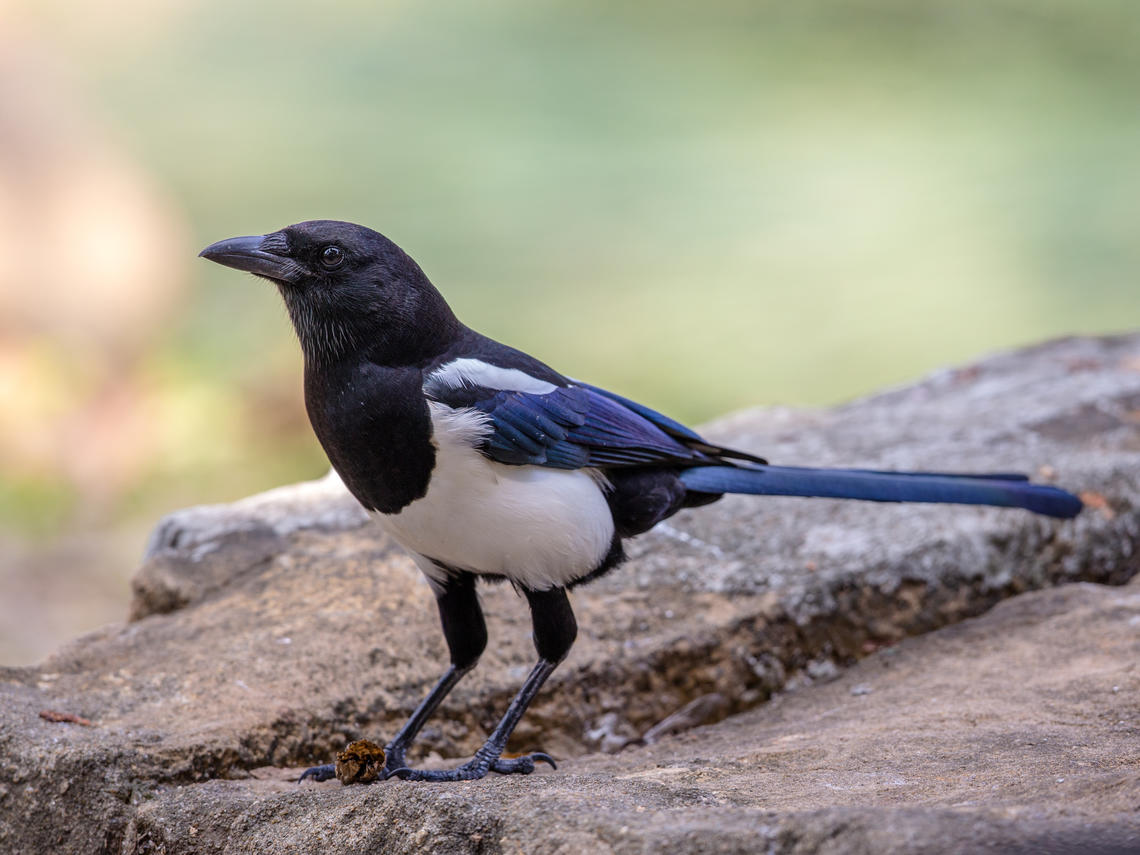
Black-billed Magpies
(Pica hudsonia)
All magpies belong to the Corvidae family, which includes crows, ravens, and jays. The black-billed magpie is common across the northwestern U.S. and western Canada year-round.17
They live in grasslands, shrublands, rocky areas, and are often seen in suburbs and cities. Their diet includes seeds, fruit, insects, rodents, garbage, and carrion.23 Interestingly, black-billed magpies often feed on parasitic ticks found on large mammals, helping control pests.6 They also create fake food caches to trick other magpies trying to steal their hidden food.3
Magpies mate monogamously and live in social groups built around paired birds. Large communities with multiple pairs and families may form.23 Mated pairs build dome-shaped nests in trees from sticks and soft materials.17 Females lay 1 to 9 eggs, incubated for about three weeks. Young are born blind and featherless, start flying at four weeks, and leave the nest after two months.23
Magpies play important ecosystem roles and face few threats except from humans. They dispose of carrion, control insect populations, and their leftover nests provide homes for other species. Wolves and coyotes often form mutual relationships with magpies, benefiting from their presence.
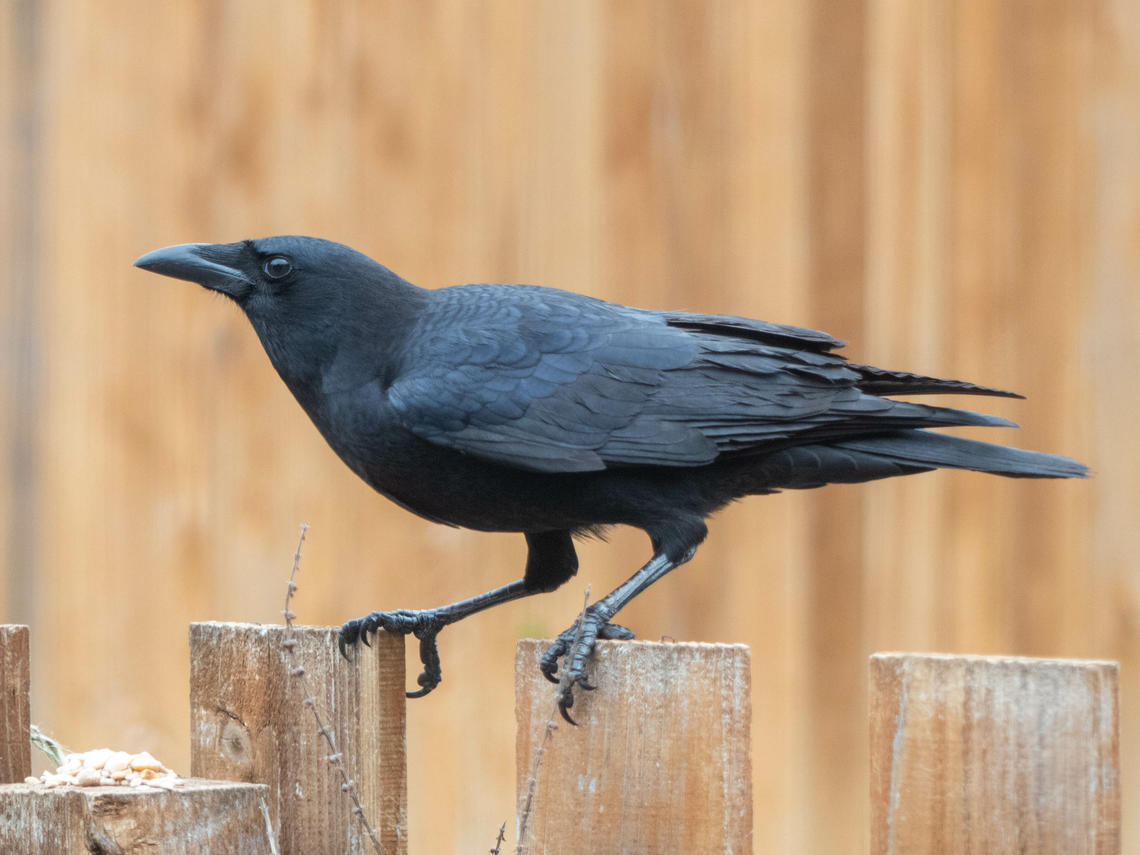
American Crow
(Corvus brachyrhynchos)
American crows have fully black bodies and are often mistaken for common ravens. They can be told apart by their smaller size, straight bill, and shorter, squared tail. As members of the Corvidae family, they’re closely related to jays, ravens, and other birds.1
They are among the most widespread birds in North America, living in varied habitats like fields, forests, neighborhoods, and garbage dumps. Like magpies, crows are very intelligent, which helps them thrive in cities.1 They can be aggressive even toward larger birds. Their diet is diverse, including invertebrates, carrion, small vertebrates, bird eggs, seeds, fruit, and nuts.24
American crows form lifelong pairs but may mate outside the pair to increase genetic diversity. Breeding happens in early spring when they build nests in coniferous or deciduous trees, shrubs, or rarely on the ground.22 Nests are made of bark, twigs, moss, feathers, fur, leaves, and other soft materials and take 5 to 13 days to build.24
Crows play an important role in ecosystems by dispersing seeds over long distances and controlling populations of rodents, insects, and amphibians. They also serve as prey for top predators.
- American Crow Identification, All About Birds, Cornell Lab of Ornithology. Allaboutbirds.org. 2022 [accessed 2022 Jul 27]. https://www.allaboutbirds.org/guide/American_Crow/id
- Banfield A, Brooks A. The mammals of Canada. [Toronto]: Published for the National Museum of Natural Sciences, National Museums of Canada by University of Toronto Press; 1977.
- Buitron D, Nuechterlein G. Experiments on Olfactory Detection of Food Caches by Black-Billed Magpies. The Condor. 1985;87(1):92-95.
- Chapman J, Flux J. Rabbits, hares and pikas. Gland: International Union for Conservation of Nature and Natural Resources; 1990.
- Ciurej A, Oblander A, Swift A, Wilson J. Melanism as a potential thermal benefit in eastern fox squirrels (Sciurus niger). European Journal of Ecology. 2019;5(2):79-87.
- Found R. Interactions between cleaner-birds and ungulates are personality dependent. Biology Letters. 2017;13(11):20170536.
- Feldhamer G. Wild mammals of North America. Baltimore: Johns Hopkins University Press; 2003.
- Jones J. Mammals of the northern Great Plains. Lincoln: University of Nebraska Press; 1983.
- Koprowski J. Sciurus carolinensis. Mammalian Species. 1994;(480):1.
- LARIVIÈRE S, WALTON L, MESSIER F. Selection by Striped Skunks (Mephitis mephitis) of Farmsteads and Buildings as Denning Sites. The American Midland Naturalist. 1999;142(1):96-101.
- Lariviere S, Walton L. Lynx rufus. Mammalian Species. 1997;(563):1.
- Lim B. Lepus townsendii. Mammalian Species. 1987;(288):1.
- Lotze J, Anderson S. Procyon lotor. Mammalian Species. 1979;(119):1.
- Marks J, Hendricks P, Casey D. Birds of Montana. Buteo Books
- Molina M, Molinari J. Taxonomy of Venezuelan white-tailed deer (Odocoileus, Cervidae, Mammalia), based on cranial and mandibular traits. Canadian Journal of Zoology. 1999;77(4):632-645.
- Mowbray T, Ely C, Sedinger J, Trost R. Canada Goose (Branta canadensis). Birds of the World. 2020.
- Pica hudsonia. IUCN Red List of Threatened Species. 2016 [accessed 2022 Jul 28].
- Smith W. Odocoileus virginianus. Mammalian Species. 1991;(388):1.
- Snow D, Perrins C, Gillmor R. The birds of the western Palearctic. Oxford: Oxford University Press; 1998.
- Sokolov V, Hoffmann R, Smith A. Lagomorphs. Enfield, NH: Science Publishers; 2009.
- Teaford J. Eastern gray squirrel (Sciurus carolinesnis). US Army Corps of Engineers Wildlife Resources Management Manual. 2022: Section 4.7.1. https://usace.contentdm.oclc.org/digital/collection/p16021coll3/id/574/rec/1
- Townsend A. Extrapair Copulations Predict Extrapair Fertilizations in the American Crow. The Condor. 2009;111(2):387-392.
- Trost C. Black-billed Magpie (Pica hudsonia). Birds of the World. 2020.
- Verbeek N. American crow: Corvus brachyrhynchos (The Birds of North America). Philadelphia: Birds of North America Inc; 2002.
- Verts B. The biology of the striped skunk. Urbana; 1967.
- Wade-Smith J, Verts B. Mephitis mephitis. Mammalian Species. 1982;(173):1.
- Walker E, Paradiso J. Mammals of the world. Baltimore, Md.: The Johns Hopkins University Press; 1975.
- Zhang V, Williams C, Theimer T, Buck C. Reproductive and Environmental Drivers of Time and Activity Budgets of Striped Skunks. Integrative Organismal Biology. 2019.
What to do if you find orphaned, injured, or dead wildlife
There are many organizations across Alberta that can help with injured, orphaned, or dead wildlife. Each one has different training, resources, and permits to handle specific species or situations. Some specialize in birds, others in mammals or reptiles. Contacting the right group ensures the animal is treated safely and with the right care.

